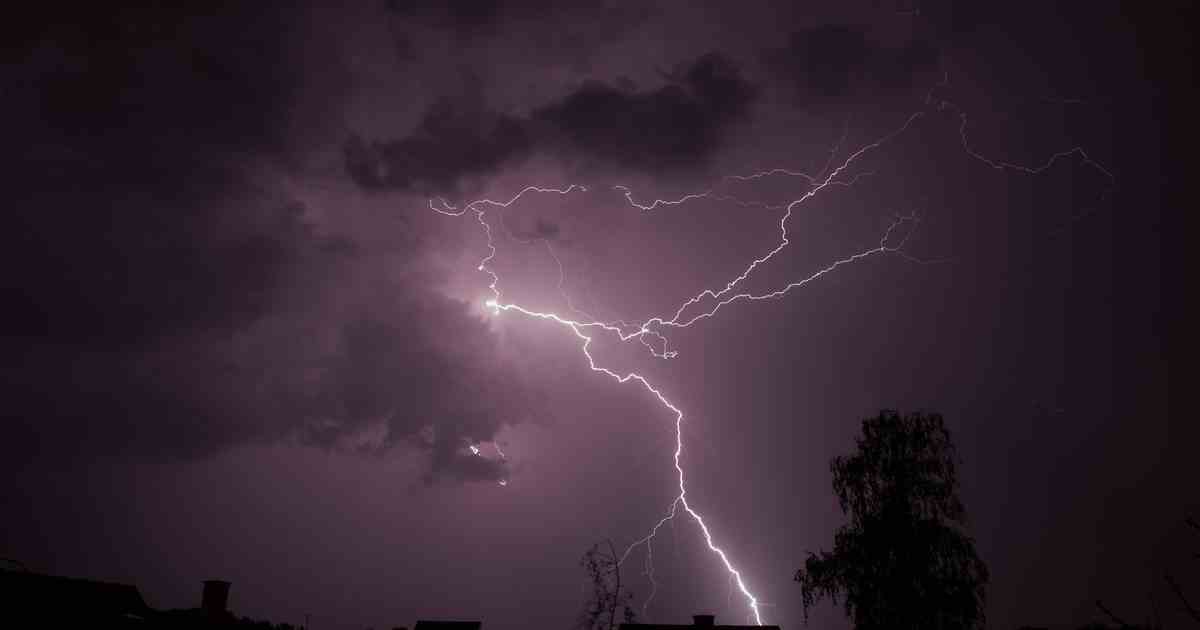Weather in North Rhine-Westphalia
:
DWD warns of severe thunderstorms, heavy rain and hail on Monday
Lightning flashes in the sky during a thunderstorm (icon image). Photo: dpa/Nicolas Maeterlinck
updates meal The German weather service forecasts heavy thunderstorms, heavy rain, hail and stormy gusts in NRW for the start of the week. But it’s not only uncomfortable on Monday.
The weather in North Rhine-Westphalia can get uncomfortable on Monday afternoon. As reported by the German Weather Service (DWD), local storms are expected over the course of the day. Heavy showers or short thunderstorms with heavy rain between 15 and 25 liters per square meter per hour and strong gusts of 55 kilometers per hour will sweep across the country.
Locally, there could even be heavy rain of up to 40 liters of precipitation in a short time. In addition, isolated gusts of wind between 70 and 85 km/h are possible, sometimes also small-grain hail.
Towards the evening, the focus shifts to the north-eastern half of the country before the showers and thunderstorms hesitantly pull away during the night on Tuesday. According to the DWD, the situation will gradually calm down on Tuesday. There will be a mix of sun and clouds, and there will be mostly no precipitation, only local showers are to be expected. According to the forecast, the temperatures will rise to 23 to 26 degrees, in the Hochsauerland they will be around 19 degrees. The wind then blows only moderately.
In the night to Wednesday it was increasingly slightly cloudy or clear. Locally it can be foggy, but no precipitation. Temperatures in North Rhine-Westphalia drop to lows of 14 to 10 degrees on Wednesday night and 10 to 7 degrees in the mountains.
Lunar eclipse at the start of the week on May 16th
At the beginning of the week, stargazers were able to enjoy a special event – on Monday morning there was a spectacle for early risers: skygazers could observe a total lunar eclipse – although not everywhere in Germany. Because in some places the earth’s satellite had already disappeared behind the horizon in the south-west before it was able to completely immerse itself in the shadow of the earth. In addition, the sky was already quite bright. Observers were only able to follow a partial lunar eclipse, as the chairman of the Association of Star Friends in Germany, Sven Melchert, explained at the request of the German Press Agency.
During the total as well as the partial lunar eclipse, the moon covered by the earth’s shadow shines in reddish, sometimes only in pale colors. According to the DWD, this is related to the sunlight deflected in the earth’s atmosphere. According to a representative survey by the opinion research institute Yougov, more than a third of people in Germany have planned to watch at least phases of the lunar eclipse.
Totality began at 5:29 a.m., just as the Trabant is setting as seen from central Germany, Melchert said. Further to the east one misses this spectacle, further to the west one can observe the total phase for a short time. The middle of the eclipse was reached at 6.12 a.m., the total phase ended shortly before 7 a.m.
“A lunar eclipse describes the astronomical process in which the moon moves through the shadow space of the earth,” says the homepage of the DWD in Offenbach. Such an event only occurs on a full moon and when the sun, earth and moon are exactly in line in space. However, it does not automatically occur with every full moon. “The reason for this is that the orbit of the moon around the earth is inclined by about five degrees compared to the orbit of the earth around the sun, in which the earth’s shadow is located,” says the DWD. Therefore, the full moon usually passes below or above the shadow of the earth.

